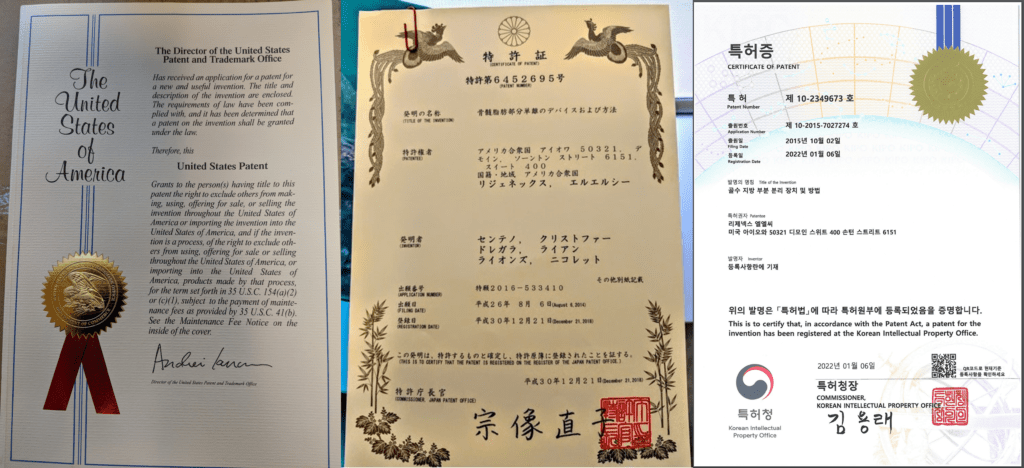Regenexx Snags Yet Another Patent

You may or may not know that Regenexx has a full lab and clinical research team that’s constantly pushing the envelope of what we know in Orthobiologics. Those teams generate new concepts for treatments and sometimes all of that ends up generating a new patent. This morning let’s go over how that works through a Korean patent we were issued this week.
Regenexx Patents
How does Regenexx generate new patents? Our intellectual property portfolio is rich in two areas: lab processing and devices. While we always file for a US patent, we often file for patients in other parts of the world like Europe and Asia.
Our Korean Patent
Above you see three of our Patents. On the left is one of our US Patents and in the middle one of our Japanese patents and then on the right the new Korean patent. That patent covers a novel process to isolate the stem cell fractions within a Bone Marrow Aspirate sample. Let’s dig into what’s going on there.
The Korean patent you see has already been granted in the US and has to with the first key breakthrough in bone marrow processing since the 1960s. Decades ago it was discovered that if you centrifuge a Bone Marrow Aspirate, that creates a “Buffy Coat”. That’s a middle layer that contains a stem cell rich fraction. You can then use various methods to isolate it, but no matter how you do that, this concept is half a century old.
The Buffy Coat Dilemma
All devices on the market only isolate that Buffy Coat stem cell fraction. It doesn’t matter how simple or sophisticated they are, that’s all you get in your Bone Marrow Concentrate if you use a commercial bedside machine. In addition, the devices on the market are not stellar at isolating that fraction because of the huge variability between human samples.
Sample variability is a tough mistress in making one size fits all devices and thus these machines and kits are very inefficient at concentrating the buffy coat. For example, in the lab, we can get a 20X concentration while most bedside machines produce only 3-7X concentration. Why? Because the position of the Buffy Coat in the centrifuged tube varies. In addition, its size is also wildly different between patients. Hence, if you design a machine without the intelligence of a human lab processor, it’s always going to leave lots of cells on the table.
More Stem Cell Fractions
While bedside machines perform poor isolations of the Buffy Coat, what if there were other stem cell fractions in the bone marrow that these devices were throwing in the trash? Meaning more stem cells in a Bone Marrow Concentrate that could be injected into the patient, but were being discarded by the bedside machine and kit? It turns out that this is what’s been happening, hence the new patents.
For years, Regenexx has not only been concentrating the Buffy Coat stem cell fraction more effectively in our flexible lab platforms in our licensed clinics, but we’ve also developed novel techniques to isolate a new stem cell fraction in the marrow. That discovery lead to multiple device patents being filed and this Korean addition is the newest of that collection.
What does this mean to a patient? If you’re getting a real stem cell procedure using bone marrow, our flexible lab platform can isolate far more stem cells out of that bone marrow than the average clinic using a simple bedside centrifuge. That could mean the difference between results and no results.
Best Looking Patent?
It is interesting to see the vast differences in how each country creates its patent as art. The American patent harkens back to the old wild west. The Japanese patent is steeped in the rich cultural history of that country with flying phoenixes (Ho-o) representing the emperor. The Korean patent has scientific-looking symbols and lines representing that country’s recent technological rebirth.
The upshot? At Regenexx our patents represent our commitment to improving Orthobiologics. We are not standing still or resting on our laurels. We are constantly pushing the envelope on what we know and building our intellectual property portfolio.

If you have questions or comments about this blog post, please email us at [email protected]
NOTE: This blog post provides general information to help the reader better understand regenerative medicine, musculoskeletal health, and related subjects. All content provided in this blog, website, or any linked materials, including text, graphics, images, patient profiles, outcomes, and information, are not intended and should not be considered or used as a substitute for medical advice, diagnosis, or treatment. Please always consult with a professional and certified healthcare provider to discuss if a treatment is right for you.